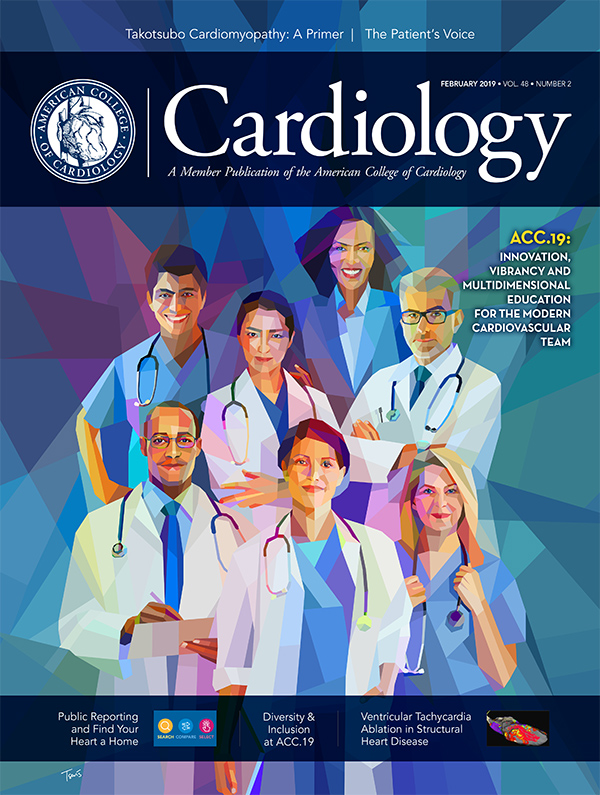Harold on History | The STS/ACC TVT Registry: A Transformational Partnership
The evolution of percutaneous valve replacement – in just 17 years from concept to standard of care for patients with native calcific aortic stenosis – is a remarkable success story, bringing new options to many patients previously considered untreatable.
Many individuals deserve credit for advancing this field, including G. Alain Cribier, MD, FACC, who pioneered the concept of percutaneous transcatheter aortic valve replacement (TAVR). Cribier along with Martin B. Leon, MD, FACC, and Israeli engineers designed models for a balloon-expandable transcatheter heart valve.
Valvular Disease at ACC.19
Don't miss these highlights from the Valvular Heart Disease Learning Pathway.
For more information on these and other meeting highlights, use the Online Planner or the ACC.19 App.
- Tricuspid Valve: The Middle Child of Valvular Heart Disease? (Session 695)
- Improving TAVR Outcomes: It's Not Just the Valve! (Session 707)
- Highlighted Original Research: Valvular Heart Disease and the Year in Review (Session 912)
- The Role of Vasculature in Valvular Heart Disease (Session 773)
- Road to Transcatheter Mitral Valve Therapies (Session 721)
- Aortic Insufficiency and Aortopathies (Session 621)
Hear the results of the PARTNER 3 trial and more first-hand at the Joint ACC/New England Journal of Medicine Late-Breaking Clinical Trials Session on Sunday from 8:00 – 9:15 a.m.
Get inspired by the legends in cardiovascular medicine – including Michael J. Mack, MD, FACC – in the Engage@ACC.19 Studio on March 18, from 11:15 a.m. - 12:15 p.m. Also meet Harvey D. White, DSc, FACC, and Richard E. Kuntz, MD, in this interactive, interview session.
Be in the room when Martin B. Leon, MD, FACC, is recognized with ACC's Lifetime Achievement Award on Monday, March 18 as part of ACC's revamped Convocation event honoring awardees, recognizing new Fellows and Associates, and welcoming ACC's new president.
In April 2002, Cribier confirmed the feasibility of TAVR, followed by rapid expansion of the technology to other patients. Subsequent clinical trials, including PARTNER, have validated the clinical use of TAVR in a variety of patient settings.
New trials continue to build on this body of research, as well as expand the transcatheter approach to the mitral valve.
At ACC.19, the PARTNER 3 trial, for which Leon is a principal investigator, along with Michael J. Mack, MD, FACC, will be presented as a Late-Breaking Clinical Trial (LBCT). PARTNER 3 along with another trial being presented by Michael J. Reardon, MD, FACC, will likely answer the question of whether TAVR can be safely extended to include low-risk patients.
In addition, LBCT attendees will hear two presentations from the COAPT study providing more insights into mitral valve procedures.
These advances and the fast-paced growth of transcatheter valve therapy are due in no small part to the power of the STS/ACC TVT Registry.
A visionary collaborative endeavor, conceived of and nurtured by David R. Holmes Jr., MD, MACC, and Mack, who were then the president of the ACC and the Society of Thoracic Surgeons (STS), respectively, it brought together for the first time all the relevant stakeholders: Centers for Medicare and Medicaid Services (CMS), U.S. Food and Drug Administration (FDA) and industry, along with the professional societies.
This novel approach for the joint creation of the Registry has allowed for its use for hospital reimbursement from CMS and as postmarket surveillance.
"By linking the NCDR and STS databases, it will subsequently become a robust research engine for comparative effectiveness and cost-effectiveness research," wrote Holmes and Mack on the transformational troika of technology, relationships and approaches advancing transcatheter valve therapy in a President's Page in February 2012 in the Journal of the American College of Cardiology.
Indeed it has, with regular contributions to the published literature (see this month's JACC in a Flash).
What are some of the advances since the FDA approved the first transcatheter aortic valve in 2011? Balloon-expandable and self-expanding TAVR systems with lower-profile delivery systems with decreased sheath size requirements that have changed access routes for percutaneous valve replacement.
Expanded indications for TAVR now include intermediate-risk patients and other novel interventions such as for the mitral valve. Refinement of patient selection. Increasing use of monitored sedation rather than general anesthesia and improvement in rates of paravalvular leak. Increasing procedural volumes for TAVR across the U.S. with excellent outcomes. Globally, TAVR procedures are expected to exceed 300,000 a year by 2025.
Some 11 million Americans have heart valve disease, but most have little awareness or knowledge about this potentially disabling and deadly disease. On February 22, the National Heart Valve Disease Awareness Day campaign, supported by the ACC, will work to address this gap. Click here for clinician and patient education tools.
The concept of the heart team has also been solidified by the STS/TVT Registry collaboration, with quality improvement data further stimulating increased cooperation among heart team members leading to better quality control and clinical outcomes.
Relevant to the increased number of TAVR programs is a volume-outcome association that has been demonstrated using Registry data, showing an inverse association between increasing case volume and lower in-hospital mortality, vascular complications and bleeding.
The Registry data has also played the critical role of providing evidence for clinical documents and recommendations that help ensure the appropriate use of percutaneous valve replacement therapies.
The ACC has partnered with STS and other professional societies, including the Society for Cardiovascular Angiography and Interventions (SCAI), the American Association for Thoracic Surgeons (AATS), to develop these documents.
As we reflect on this remarkable progress, let us also reflect on the transformational power of collaboration.
Keywords: ACC Publications, Cardiology Magazine, Transcatheter Aortic Valve Replacement, Aortic Valve, Centers for Medicare and Medicaid Services, U.S., Mitral Valve, Hospital Mortality, Tricuspid Valve, Patient Selection, Quality Improvement, Cost-Benefit Analysis, Research Personnel, Standard of Care, United States Food and Drug Administration, Heart Valve Diseases, Heart Valve Prosthesis, Aortic Valve Stenosis, Registries, Awards and Prizes, Calcinosis, Quality Control, Anesthesia, General, Surgeons, Vascular Diseases, Angiography, Coronary Angiography, ACC19, National Cardiovascular Data Registries, STS/ACC TVT Registry
< Back to Listings

